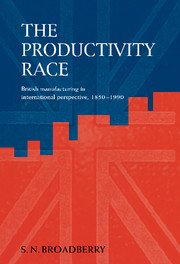Book contents
- Frontmatter
- Contents
- List of figures
- List of tables
- Acknowledgements
- Glossary of terms and company names
- 1 Introduction and overview
- Part 1 measuring comparative productivity performance
- Part 2 explaining compartive productivity performence
- 6 Technology
- 7 Economic geography: markets and natural resources
- 8 Accumulation of physical and human capital
- 9 Competition and adjustment
- Part 3 reassessing the performance of British industry
- Bibliography
- Index
8 - Accumulation of physical and human capital
Published online by Cambridge University Press: 28 October 2009
- Frontmatter
- Contents
- List of figures
- List of tables
- Acknowledgements
- Glossary of terms and company names
- 1 Introduction and overview
- Part 1 measuring comparative productivity performance
- Part 2 explaining compartive productivity performence
- 6 Technology
- 7 Economic geography: markets and natural resources
- 8 Accumulation of physical and human capital
- 9 Competition and adjustment
- Part 3 reassessing the performance of British industry
- Bibliography
- Index
Summary
Introduction
The analysis so far suggests that endowments and demand conditions dictate a more machine-intensive technology in the United States, leading to higher labour productivity than in Europe. It might be expected, then, that an approach relating comparative labour productivity to comparative fixed capital per worker via a conventional production function would be successful in explaining international differences in labour productivity. However, this chapter shows that in practice differences in total factor productivity (TFP), incorporating fixed capital as well as labour inputs, are almost as large as differences in labour productivity. Although there are a number of measurement and conceptual problems, which make it likely that the role of physical capital is understated in the traditional growth accounting or levels accounting approach, it is also necessary to look more closely at the accumulation of human capital.
Here, it is important to distinguish between the different types of human capital needed to operate mass production and flexible production systems, since the standard data on years of schooling suggest little difference between the major industrialised countries (Maddison, 1987, table A12). Even if we accept that there are problems of international comparability with the schooling data, there must still be doubts about the precise links between general schooling and the jobs actually performed by the majority of workers in manufacturing (Howell and Wolff, 1992). Hence it is important to look at human capital accumulation that is more directly relevant to the skills actually used in the manufacturing sector.
- Type
- Chapter
- Information
- The Productivity RaceBritish Manufacturing in International Perspective, 1850–1990, pp. 104 - 128Publisher: Cambridge University PressPrint publication year: 1997



